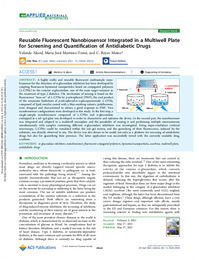Por favor, use este identificador para citar o enlazar este ítem:
https://hdl.handle.net/11000/30502
Reusable Fluorescent Nanobiosensor Integrated in a Multiwell Plate
for Screening and Quantification of Antidiabetic Drugs
Título :
Reusable Fluorescent Nanobiosensor Integrated in a Multiwell Plate
for Screening and Quantification of Antidiabetic Drugs |
Autor :
Alacid Martínez, Yolanda Inmaculada 
Martínez Tomé, María José
Mateo , C. Reyes |
Editor :
ACS Publications |
Departamento:
Departamentos de la UMH::Agroquímica y Medio Ambiente |
Fecha de publicación:
2021-05 |
URI :
https://hdl.handle.net/11000/30502 |
Resumen :
A highly stable and reusable fluorescent multisample nanobiosensor
for the detection of α-glucosidase inhibitors has been developed by
coupling fluorescent liposomal nanoparticles based on conjugated polymers
(L-CPNs) to the enzyme α-glucosidase, one of the main target enzymes in
the treatment of type 2 diabetes. The mechanism of sensing is based on the
fluorescence “turn-on” of L-CPNs by p-nitrophenol (PNP), the end product
of the enzymatic hydrolysis of p-nitrophenyl-α-D-glucopyranoside. L-CPNs,
composed of lipid vesicles coated with a blue-emitting cationic polyfluorene,
were designed and characterized to obtain a good response to PNP. Two
nanobiosensor configurations were developed in this study. In the first step, a
single-sample nanobiosensor composed of L-CPNs and α-glucosidase
entrapped in a sol−gel glass was developed in order to characterize and optimize the device. In the second part, the nanobiosensor
was integrated and adapted to a multiwell microplate and the possibility of reusing it and performing multiple measurements
simultaneously with samples containing different α-glucosidase inhibitors was investigated. Using super-resolution confocal
microscopy, L-CPNs could be visualized within the sol−gel matrix, and the quenching of their fluorescence, induced by the
substrate, was directly observed in situ. The device was also shown to be useful not only as a platform for screening of antidiabetic
drugs but also for quantifying their presence. The latter application was successfully tested with the currently available drug, acarbose.
|
Palabras clave/Materias:
α-glucosidase inhibitors
nanobiosensor
fluorescent conjugated polymers
liposomal nanoparticles
acarbose
multiwell plate
antidiabetic drugs |
Área de conocimiento :
CDU: Ciencias puras y naturales: Química |
Tipo de documento :
info:eu-repo/semantics/article |
Derechos de acceso:
info:eu-repo/semantics/openAccess |
DOI :
https://doi.org/10.1021/acsami.1c02505 |
Aparece en las colecciones:
Artículos Agroquímica y Medio Ambiente
|
 La licencia se describe como: Atribución-NonComercial-NoDerivada 4.0 Internacional.
La licencia se describe como: Atribución-NonComercial-NoDerivada 4.0 Internacional.
 La licencia se describe como: Atribución-NonComercial-NoDerivada 4.0 Internacional.
La licencia se describe como: Atribución-NonComercial-NoDerivada 4.0 Internacional.
.png)
